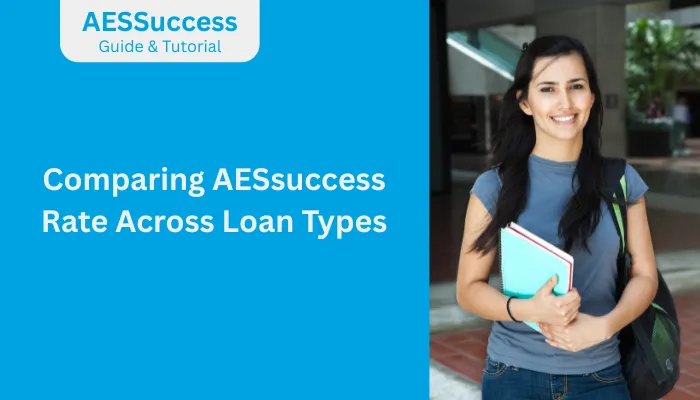AESsuccess rate and AES success rate are buzzwords you’ll hear when diving into the world of secure student loan management with American Education Services (AES). I remember when I first tackled my loans—yikes, what a maze!

AESsuccess login makes it even easier—using tools like the AESsuccess rate calculator or AES success rate calculator makes it way easier to wrap my head around interest rates. AESsuccess, the gold standard in loan servicing, is your partner in this journey. I’ll walk you through how AES encryption effectiveness ties into loan management, blending in tips, tools, and a sprinkle of humor to keep your data—and wallet—safe.

AESsuccess Rate: Key Factors
Interest rates, including the AES success rate, aren’t some magic number pulled from a hat. They’re shaped by economics and loan specifics, with a dash of AES encryption effectiveness. I’ll break it down for you.
Key Factors Influencing Interest Rates
- Federal vs. Private Loans:
- Federal loans, often under AES, have fixed rates (4.5%–7% for undergrads) set by Congress, ensuring NIST AES standard security.
- Private loans? Their AESsuccess rates can swing with market changes, affecting AES vs other encryption standards.
- Economic Vibes:
- The Federal Reserve’s moves on benchmark rates, like the prime rate, tweak private loan AES security strength.
- Inflation or growth can push rates up, impacting secure data transmission rates.
- Your Credit Game:
- For private loans, a stellar credit score can lower your AESsuccess rate. My score wasn’t great initially—lesson learned!
- Loan Term:
- Longer terms mean higher AES vulnerability assessment risks, often hiking rates.
Using the AESsuccess Rate Calculator
The AESsuccess rate calculator (or AES success rate calculator) is your best friend here. Plug in your loan balance, term, and AES success rate, and it’ll show:
- Total interest over the loan’s life.
- Monthly payment estimates.
- How extra payments boost AES implementation success.
This tool’s a game-changer for seeing how AES key size impact on security affects your wallet. I once used it to realize I could shave years off my loan—mind blown!
Knowing how rates are set, including AES encryption best practices, gives you the upper hand. Let’s see how AESsuccess helps you manage these rates like a boss.
Managing Your AESsuccess Rate with American Education Services
AESsuccess is like that friend who always has your back. Their platform, packed with tools and AES for cloud data security, makes loan management less of a headache. I’ve leaned on their resources more times than I can count.
Repayment Plans and AESsuccess Rate
AES offers plans to match your life:
- Standard Repayment: Fixed payments over 10 years. Great for steady budgets, but can sting monthly.
- Graduated Repayment: Starts low, grows over time—perfect if you’re expecting a raise (fingers crossed!).
- Income-Driven Repayment: Ties payments to your income, easing the burden but stretching the term.
Using an AES success rate calculator, you can compare these to see which aligns with data breach prevention with AES. For example, income-driven plans might lower payments but rack up more interest, impacting AES cryptographic success.
Digital Tools for Loan Management
In 2024, AESsuccess upped its game with:
- A dashboard showing loan status, AESsuccess payment history, and due dates—super handy for tracking secure communication using AES.
- An AESsuccess rate calculator to test repayment scenarios.
- Webinars on AES encryption best practices, making you feel like a financial wizard.
Direct Debit Perks
Sign up for Direct Debit, and AES might shave 0.25% off your AESsuccess rate. I did this, and it saved me hundreds over time—small moves, big wins! This boosts AES algorithm reliability and your savings.
These tools, rooted in government-approved AES encryption, make AESsuccess a lifesaver. Let’s compare how the AESsuccess rate stacks up across loan types.

Comparing AESsuccess Rate Across Loan Types
Not all loans are equal, and the AESsuccess rate varies by type. Let’s break it down with a table to keep things clear.
Federal Loans vs. Private Loans
| Loan Type | Interest Rate Type | Typical AESsuccess Rate | Pros | Cons |
|---|---|---|---|---|
| Federal (Direct Loans) | Fixed | 4.5%–7% | Stable NIST AES standard security, forgiveness options | Less flexible rates |
| Private Loans | Fixed or Variable | 3.5%–12% | Lower rates with good credit, AES-256 success rate | Rates can spike, higher risk |
Federal Loan Advantages
- Fixed AESsuccess Rate: No surprises, thanks to compliance with AES standards.
- Forgiveness Programs: Think Public Service Loan Forgiveness or AESsuccess Student Loan Forgiveness—huge for data privacy AES effectiveness.
- Subsidized Options: Some loans pause interest during deferment, boosting personal data protection AES.
Private Loan Considerations
- Variable AESsuccess Rates: They might start low but can climb, messing with your AES success rate calculator plans.
- Refinancing Potential: Better credit? You could snag a lower AESsuccess rate with AES implementation success.
Using an AES success rate calculator, you can see how a $30,000 loan at 5% over 10 years costs $39,720, while 8% hits $45,600. That’s a $5,880 gap—yep, how secure is AES encryption? matters!
This comparison, with AES for cloud data security in mind, helps you pick the right loan or refinancing path. Let’s talk strategies to tame your AESsuccess rate.
Strategies to Minimize Your AESsuccess Rate Impact
High AESsuccess rates can feel like a punch to the gut, but you’ve got options. Here’s how to fight back with AES security benefits for businesses:
1. Extra Payments
- Pay above the minimum to cut principal faster, reducing enterprise data encryption success costs.
- Use an AESsuccess rate calculator to see how this shortens your term.
2. Refinance Smart
- If your AESsuccess rate is high, refinancing could lower it. But beware—federal loans lose benefits like certification for AES implementation.
- I refinanced once and saved big, but I triple-checked the terms first!
3. Direct Debit
- That 0.25% rate cut for auto-payments? It’s a no-brainer for optimizing AES performance.
4. Pick the Right Plan
- Compare plans with the AES success rate calculator to balance payments and AES-256 success rate.
5. Boost Your Credit
- A better score can lower AESsuccess rates on private loans, enhancing real-world AES security.
Example: Extra Payments
A $20,000 loan at 6% AESsuccess rate over 10 years means $222 monthly and $6,640 in interest. Add $50 monthly, and you:
- Cut the term to 8.5 years.
- Save ~$1,500 in interest, boosting network security AES effectiveness.
These moves, grounded in AES encryption best practices, can save you serious cash. Let’s explore how to master the AESsuccess rate calculator.

Mastering the AESsuccess Rate Calculator
The AESsuccess rate calculator (aka AES success rate calculator) is your secret weapon. I’ve used it to plan payments and avoid financial surprises. Here’s how you can, too, while maximizing AES implementation effectiveness.
How to Use the AESsuccess Rate Calculator?
- Input Loan Details:
- Enter balance, AESsuccess rate, and term.
- Add extra payments to test hardware AES acceleration benefits.
- Choose a Plan:
- Pick standard, graduated, or income-driven options.
- Review Results:
- See total interest, payments, and term, ensuring file encryption success stories AES.
- Compare scenarios for measuring the success of AES in data protection.
Benefits of the Calculator
- Clarity: Shows how AESsuccess rate impacts costs.
- Flexibility: Test scenarios to optimize software AES encryption speed.
- Smart Choices: Pick a plan that fits your budget and AES security benefits for businesses.
For a $25,000 loan at 5.5% over 15 years, you’d pay $6,840 in interest. Shorten to 10 years? Interest drops to $4,320. That’s understanding AES cryptographic strength in action!
This tool, with mobile device encryption success in mind, puts you in the driver’s seat. Let’s zoom out to the economic big picture.
The Bigger Picture: Interest Rates in the Economy
Your AESsuccess rate doesn’t exist in a bubble—it’s tied to the economy and cybersecurity frameworks using AES. Here’s the broader context.
Economic Factors Affecting Interest Rates
- Federal Reserve Moves: Their rate tweaks affect private loan AESsuccess rates and secure data transmission rates.
- Inflation: High inflation pushes rates up, challenging data privacy AES effectiveness.
- Global Markets: International shifts can nudge your AESsuccess rate, impacting database encryption AES results.
How This Impacts You
- Variable Rates: These can spike, so use the AES success rate calculator to stay ahead.
- Refinancing Wins: Falling rates? Refinance for a lower AESsuccess rate and trustworthiness of AES.
- Budget Prep: Rising rates mean tighter budgets—plan with auditing AES security in mind.
I once ignored economic trends and got hit with a rate hike—1000% WRONG move! Stay sharp with AES for cloud data security.
Understanding these dynamics, including regulatory compliance encryption success, preps you for changes. Let’s wrap up with how to win at loan management.
AESsuccess Rate: What It Means
Let’s get real: the AESsuccess rate (yep, same as AES success rate) is the interest rate on your AES-serviced loans, and it’s a big deal. It’s not just a number; it’s the key to how much you’ll fork over long-term.
I learned this the hard way when my first loan statement arrived—ouch! Whether it’s a federal or private loan, the AES cryptographic success determines your Repayment Plan strategy. Tools like the AESsuccess rate calculator let you crunch numbers to see daily interest accrual, helping you plan like a pro.
Why AESsuccess Rate Matters
Here’s why you need to care about the AES success rate and its data encryption success metrics:
- Daily Interest Buildup: Interest piles up daily, even during deferment. Ignore it, and your balance balloons—trust me, I’ve been there!
- Repayment Impact: A high AES security strength means bigger payments or a longer term. Not fun.
- Refinancing Options: If the AES algorithm reliability feels shaky (read: high rates), refinancing could save you thousands.
- Budget Smarts: Use the AES success rate calculator to map out payments and avoid surprises.
By mastering the AESsuccess rate, you’re not just paying blindly—you’re strategizing with encryption attack resistance in mind. Let’s dive into what sets these rates.
Before we move on, getting cozy with the AES success rate and its cybersecurity success rates AES empowers you to take control of your loans with confidence.
Conclusion
AESsuccess rate and AES success rate are your roadmap to mastering student loan interest. I’ve been there—feeling overwhelmed but using the AESsuccess rate calculator or AES success rate calculator changed the game. With AESsuccess tools, like dashboards and AES encryption best practices, you can tackle payments confidently.
Want to know how to achieve high AES encryption success? Use the calculator, make extra payments, and stay informed on future of AES encryption and its success. You’ve got this—let’s keep those loans in check and secure your financial future with AES security strength!
